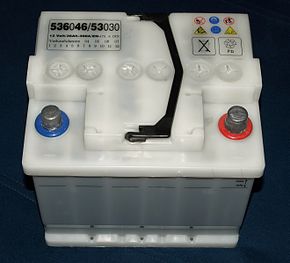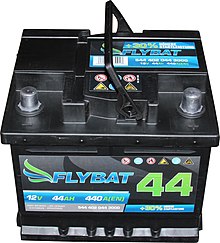Automotive battery

This article is currently undergoing quality assurance in the WikiProject Electrical Engineering of the Portal Elektrotechnik. If you are familiar with the topic, you are welcome to participate in the review and possible improvement of the article. The exchange of opinions on this topic can be found in the discussion (enter article "Starter battery").
![]()
This article or section is still missing the following important information:
special forms such as "NATO block
Help Wikipedia by researching and adding them.
The starter battery, also known as a car battery or vehicle battery in the case of motor vehicles, is an accumulator which, among other things, supplies the electrical energy for the starter of an internal combustion engine, for example in motor vehicles, power generating sets or the gas turbine of an aircraft. Lead-acid batteries are often used as starter batteries.
An accumulator which is not used for starting but as a source of energy for the traction drive of an electric vehicle, for example in electric cars or hybrid vehicles, is called a traction battery. Its structure differs from the starter battery.
In order to protect the battery required for propulsion from unintentional discharge, vehicles that are equipped with consumers that are used independently of the driving operation often have another accumulator to supply the on-board network. Motorhomes usually contain an additional accumulator to supply the living area.

Car battery with a voltage of 12 V and capacity of 36 Ah. Earlier, open version with block lid, transparent housing, central degassing and the possibility of refilling distilled water after unscrewing the six round plugs.

Modern lead-calcium starter battery 12 V 44 Ah (high current battery), closed system, maintenance-free.
Batteries in motor vehicles
The starter battery fulfils various tasks in the motor vehicle:
- It supplies relevant assemblies with voltage before the starting process (control units, injection system, ignition coil, preheating system).
- It supplies the starter motor (starter) with energy.
- It also supplies the vehicle's emergency lighting (lights, hazard warning lights) when the engine is not running.
- It smoothes the alternator voltage and reduces voltage peaks during regular driving.
- When the vehicle is stationary, it supplies various consumers with energy (clock, radio, control unit).
As soon as the engine is running, the alternator takes over the voltage supply of the system and recharges the starter battery. Starter batteries are also referred to as SLI batteries after the consumers starter, light and ignition.
The starting of an internal combustion engine by the electric starter motor requires brief currents of several 100 to 1000 amperes. The car starting process takes two to fifteen seconds for well-maintained engines and up to one hundred seconds for older vehicles. During this process, the battery loses up to about 0.2 Ah in the case of petrol engines (with a two-second starting time) and up to about 0.3 - 0.4 Ah in the case of diesel engines (7-second starting time with pre-glowing). About 3-5 minutes (driving time) are required to recharge the resulting 0.2 Ah loss of battery charge. The starter battery must be able to supply the current even at low winter temperatures. Since the electrical voltage must not drop too much during the starting process, starter batteries have a low internal electrical resistance.
Car starter batteries and starter batteries for trucks and other commercial vehicles such as buses, construction and agricultural machinery differ in capacity and thus also in weight and dimensions. Truck batteries are standardized according to EN-50342-4: The maximum dimensions (H x W x L) are 240 mm × 273 mm × 518 mm and the capacity is up to 235 Ah.
In trucks, the voltage of the on-board network is 24 V instead of 12 V. Therefore, two 12-volt accumulators of the same type are used here, connected in series.
In passenger cars with automatic start-stop systems, conventional starter batteries are quickly overtaxed, since the significantly more frequent starting processes require increased cycle stability of the batteries. For pure start-stop operation (without recuperation), EFB (Enhanced Flooded Battery) batteries were developed, which in conventional, wet design have more lead to be able to cover the higher energy demand and contain fleece mats to stabilize the active mass (storage mass) of the plus electrode.
VRLA or AGM (Absorbent-Glass-Mat) accumulators, which have been used in standby operation and for small drives for about 50 years, have also been further developed into starter batteries. These are used for vehicles with start-stop systems and recuperation technology. With these, a generator is driven during braking to charge the accumulator. AGM accumulators allow up to four times as many charging cycles as conventional batteries. The low internal resistance due to the design also favours a rapid reaction between the acid and the plates, which means that high amounts of energy can be absorbed quickly. The expensive AGM accumulators are susceptible to increased temperatures, which is why they are often not installed in the engine compartment, but in the interior or trunk.
Accumulators using other redox systems, e.g. a lithium technology, find it difficult to compete with lead accumulators for cost reasons. These accumulators require complicated charging and protection circuits. The weight saving is very high, but the use in large-scale production cannot be justified in terms of price. Only Porsche offers LiFePO4 accumulators as starter batteries for an additional charge. LiFePO4 starter batteries for passenger cars are also on the market in the replacement business, but they cost 4-5 times as much as a comparable lead starter battery. In the scooter and motorcycle sector, there is now an extensive range of LiFePO4 starter batteries.
Batteries in aircraft
Compared to other accumulator technologies, the low-cost lead accumulator is comparatively heavy. In aircraft, nickel-cadmium accumulators are therefore used as starter batteries for starting piston engines or auxiliary power units, and increasingly nickel-metal hydride accumulators, silver-zinc accumulators and lithium-ion accumulators.
Search within the encyclopedia